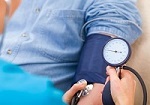Abstract: Objective To assess the effect of antihypertensive treatment on mortality and cardiovascular morbidity in people with diabetes mellitus, at different blood pressure levels. Design Systematic review and meta-analyses of randomised controlled trials. Data sources CENTRAL, Medline, Embase, and BIOSIS were searched using highly sensitive search strategies. When data required according to the protocol were missing but trials were potentially eligible, we contacted researchers, pharmaceutical companies, and authorities.
Eligibility criteria Randomised controlled trials including 100 or more people with diabetes mellitus, treated for 12 months or more, comparing any antihypertensive agent against placebo, two agents against one, or different blood pressure targets. Leer más…
 Cada 17 de mayo se conmemora el Día Mundial de la Hipertensión con la finalidad de promover la concienciación y los esfuerzos para prevenir, diagnosticar y controlar este problema de salud. El tema de este año es «¡Mida su presión arterial con precisión, contrólela y viva más tiempo!». Leer más…
Cada 17 de mayo se conmemora el Día Mundial de la Hipertensión con la finalidad de promover la concienciación y los esfuerzos para prevenir, diagnosticar y controlar este problema de salud. El tema de este año es «¡Mida su presión arterial con precisión, contrólela y viva más tiempo!». Leer más…![]()
 Este estudio se refiere sobre si la disminución de la presión arterial puede reducir el riesgo de desarrollar diabetes de tipo 2 en primer lugar y la medicación que puede marcar la diferencia si es así, para lograr este objetivo.
Este estudio se refiere sobre si la disminución de la presión arterial puede reducir el riesgo de desarrollar diabetes de tipo 2 en primer lugar y la medicación que puede marcar la diferencia si es así, para lograr este objetivo. 















DE NUESTROS LECTORES